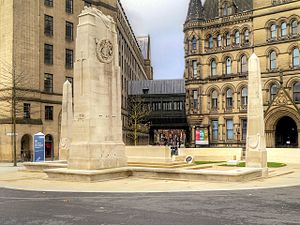Manchester Cenotaph
| The Cenotaph | |
|---|---|
| United Kingdom | |

Relocated Cenotaph in 2014
|
|
| For the British Empire (later Commonwealth) dead of both World Wars, and the British military in later wars |
|
| Unveiled | 12 July 1924 |
| Location |
53°28′43″N 2°14′34″W / 53.4787°N 2.2429°WCoordinates: 53°28′43″N 2°14′34″W / 53.4787°N 2.2429°W St Peter's Square, Manchester, England |
| Designed by | Edwin Lutyens |
Manchester Cenotaph is in St Peter's Square Manchester city centre in north-west England. The First World War memorial was designed by Sir Edwin Lutyens and now commemorates the dead of both World Wars and the British military in later wars. Built in Portland stone, it was erected in 1924 as a memorial to those who lost their lives in the First World War. It is a Grade II* listed structure.
In the aftermath of the First World War, thousands of memorials were built across Britain. Among the most prominent designers was Sir Edwin Lutyens, described by Historic England as "the leading English architect of his generation". He was one of three principal architects employed by the Imperial War Graves Commission designing memorials for towns and villages across Britain and in the Commonwealth. He designed the Cenotaph in London, the Thiepval Memorial to the Missing—the largest British war memorial anywhere in the world—and the Stone of Remembrance which appears in all large Commonwealth War Graves Commission cemeteries. Manchester's cenotaph is one of eight in England designed by Lutyens to similar specifications. The first was in Southampton although the one in London is the best-known.
Many towns and cities began erecting war memorials shortly after the armistice, but Manchester did not get underway until 1922, when a committee was formed as a result of pressure from the local branch of the Royal British Legion. The site chosen was in St Peter's Square in front of Manchester Central Library on the site of St Peter's Church which had been built there in 1789–94 by James Wyatt and demolished in 1907. The site, chosen after considerable local debate, was a compromise choice, after proposals for locating it in Albert Square and Piccadilly Gardens were rejected. Concerns raised about its proximity to St Peter's Cross, a Portland stone monument by Temple Moore commemorating the church's former location, were dismissed by the city council. After further local pressure, Lutyens was appointed the architect for the project.
...
Wikipedia
